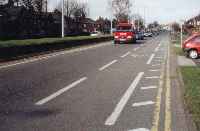
A cycle lane is an area of the carriageway marked for use by cyclists. Cycle lanes can be a useful cycle priority measure, but suffer from a number of disadvantages, mostly in terms of safety. This document sets out the Warrington Cycle Campaign policies towards cycle lanes. These policies are aimed to ensure that cycle lanes are placed at locations where they offer benefits to cyclists, while being designed to high standards to minimise the hazards.
Advantages:
- Cycle lanes can help cyclists to overtake stationary queues of traffic on congested roads.
- Cycle lanes can provide contra-flow access to one-way streets.
Disadvantages:
- Cycle lanes encourage motorists to overtake at places where it is unsafe, and to cause motorists to leave a smaller gap than they otherwise would.
- Cycle lanes make it more difficult for cyclists to overtake parked cars or avoid potholes.
- Cycle lanes make good road positioning difficult, especially on the approach to junctions.
- Cycle lanes can lead to a misplaced perception of security among novice cyclists, and encourage the unsafe practice of riding too far to the left.
- Cycle lanes require extra maintenance as they are not swept by general traffic.
- Some motorists act aggressively towards cyclists not using facilities.
|
POLICY The cycle campaign is opposed to the introduction of cycle lanes less than 2m wide. |
|---|
Cyclists need at least 2m of road space while riding on the road. This is comprised of:
- 0.6m - Minimum distance a cyclist should ride from the kerb.
- 0.6m - Width of a cyclist.
- 0.8m - Absolute minimum clearance drivers of vehicles should leave between themselves and cyclists when overtaking.
Mandatory & Advisory Cycle Lanes
Mandatory cycle lanes are marked by an unbroken white line and have the advantage that motor vehicles are prohibited from entering them. However, this does mean that the remaining carriageway must be sufficiently wide to permit motor vehicles to pass without encroaching the cycle lane.
Advisory cycle lanes are marked by a broken white line. Advisory cycle lanes may be entered by motor vehicles when necessary and safe to do so. This has the advantage that a 2m wide cycle lane can be accommodated in circumstances where a carriageway is not wide enough to permit a full width mandatory cycle lane.
The cycle campaign supports the use of mandatory cycle lanes where a carriageway is wide enough to permit a 2m wide cycle lane. If space is limited then advisory cycle lanes should be used in order to maintain the cycle lane width.
Car Parking
Cycle lanes make it considerably more difficult for cyclists to overtake parked cars as cyclists within a cycle lane do not have right of way and must negotiate into the general traffic lane. The cycle campaign is opposed to the introduction of cycle lanes at or leading to locations where car parking is either permitted or anticipated
Where parking is arranged in bays cyclists are vulnerable to car doors being thrown open and people moving out between parked cars. For safety, cycle lanes must always be at least 1.5m clear of parking bays.
Junctions
Care is needed in the design of cycle lanes approaching junctions. Cycle lanes make good road positioning difficult on the approach to junctions and can lead to conflicts with left turning vehicles. Problems also arise where a cycle lane ends at the point where a general traffic lane splits into two narrow filter lanes on the approach to a junction. This feeds cyclists and motor vehicles into the same road space with no indication of who has right of way.
There should be a clear space between cycle lanes and give-way markings at side streets. If junctions are frequent then cycle lanes will be inappropriate. Cycle lanes should not be placed to the left of left-hand filter lanes or where a significant flow of left turning traffic is expected.
Location
Cycle lanes are most useful in places where they enable cyclists to overtake queues of traffic, or to access one-way streets in a contra-flow direction.
Maintenance
Surface defects, such as potholes, flooding due blocked drains etc, are particularly hazardous in cycle lanes due to cyclists' limited space to take avoiding action. Also, cycle lanes tend to accumulate debris, as they do not benefit from the sweeping action of motor vehicles. It is important that cycle lanes are maintained regularly to a high standard and that they are swept frequently and gritted in the winter.
Surface Colour
Applying surface colouring can highlight the presence of cycle lanes in situations such as the approach to advanced stop lines or crossing side roads. However the resulting surface tends to be lumpy and uncomfortable to ride.